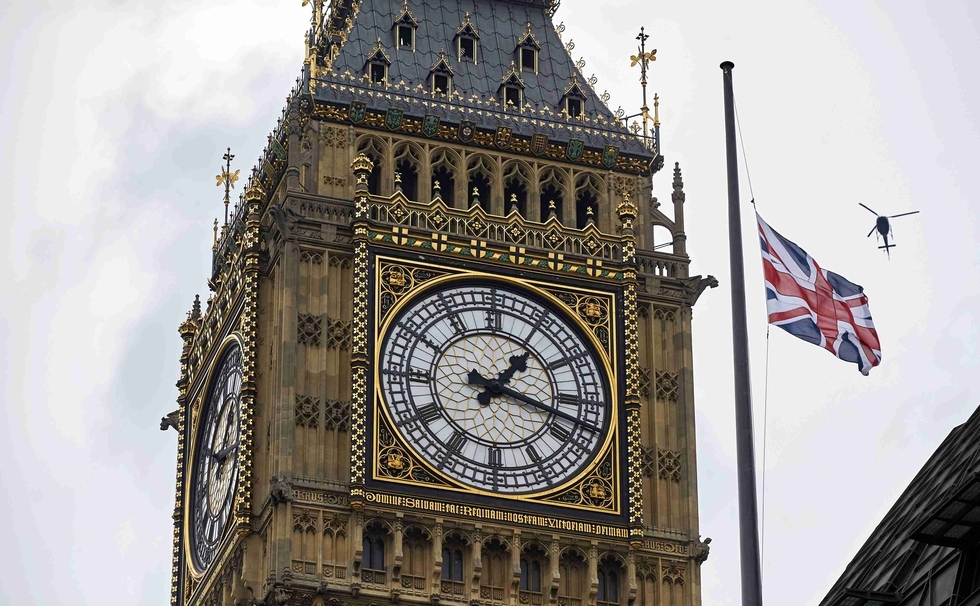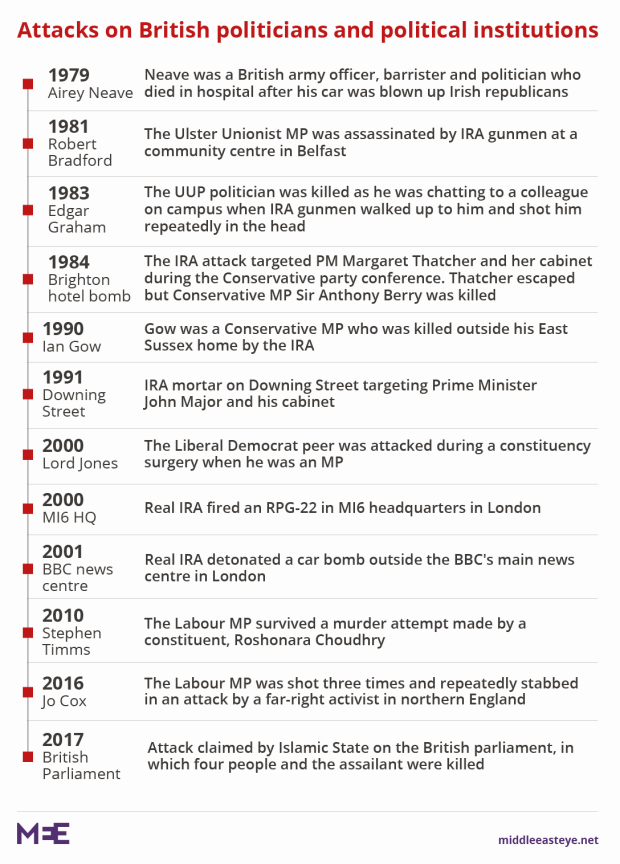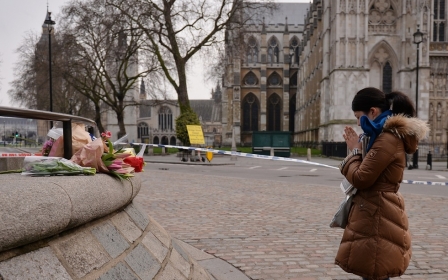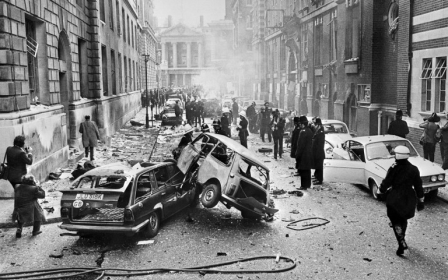Car bombs and mortar attacks: How UK politicians have come under fire

Wednesday's attack on the British parliament, in which three people and the assailant were killed, was the latest in a series of deadly incidents and attention-grabbing stunts targeting the heart of Britain's political establishment.
The culmination of the attack in which a man fatally stabbed a police officer before being shot dead himself inside the grounds of the Palace of Westminster occurred just metres away from the scene of a car bombing which killed a Conservative member of parliament in March 1979.
Airey Neave, then then-shadow Northern Ireland minister, was killed when his car exploded as he was driving out of the building's car park.
An Irish republican group, the Irish National Liberation Army, claimed responsibility for the bombing and said Neave had been targeted because of his "rabid militarist calls for more repression against the Irish people".
Other Irish republican attacks also targeted Westminster politicians and buildings during the period of Northern Ireland's troubles from the 1960s to the 1990s.
In 1973, the Irish Republican Army (IRA), the main republican militant group, placed a car bomb near the Ministry of Agriculture in Whitehall, which exploded at the same time as another bomb placed near the Old Bailey courthouse.
In 1991, the IRA launched a mortar bomb attack on nearby 10 Downing Street, the prime minister's official residence.
Nobody was killed, although one of three mortar shells fired landed in the back garden as then-prime minister John Major and his cabinet were meeting in a nearby office.
The IRA also carried out the 1984 bombing of the Grand Hotel in Brighton where then-prime minister Margaret Thatcher and many senior members of the government were staying for the Conservative Party's annual conference.
Five people including Conservative MP Anthony Berry were killed in the attack and 31 others injured. Thatcher was unharmed but was considered to have had a lucky escape with the blast causing extensive damage to the bathroom of the suite in which she was staying.
The IRA said: "Mrs Thatcher will now realise that Britain cannot occupy our country and torture our prisoners and shoot our people in their own streets and get away with it.
"Today we were unlucky, but remember we only have to be lucky once. You will have to be lucky always. Give Ireland peace and there will be no more war."
Conservative MP Ian Gow was killed by a bomb placed under his car outside his home in East Sussex in 1990 in another IRA attack.Gow had formerly been Thatcher's private secretary and the IRA said he had been targeted because of his role in shaping British government policy in Northern Ireland and because of his association with Thatcher.
Gow was the last sitting member of parliament to be killed before the shooting in June last year of Jo Cox, a Labour MP, by far-right activist Thomas Mair in her Batley and Spen constituency in the run-up to the UK's Brexit referendum.
Mair, who was jailed for life in November, shouted "Britain first" as he shot the MP in what was interpreted by some as a reference to an anti-Muslim and anti-immigrant far-right organisation.Stephen Timms, also a Labour MP, was injured in a knife attack by a constituent, Roshonara Choudhry, in East London in 2010.
Choudhry told police after her arrest that she had attacked Timms to "punish" him for voting in favour of the 2003 invasion of Iraq, in which UK forces participated in the US-led invasion.
She also told police she had been motivated to act after watching online sermons broadcast by Anwar al-Awlaki, a US-born al-Qaeda cleric who was subsequently killed in an American drone strike in Yemen.
Shortcomings in security
Others have taken advantage of shortcomings in parliamentary security to draw attention to causes including fathers' rights, opposition to the UK's fox-hunting ban, and the impact of the government's austerity cuts on people with disabilities.
In 2004, a major security alert was triggered in the House of Commons when a man was able to throw an object containing purple powder, subsequently found to be flour, at then-prime minister Tony Blair as he stood at the dispatch box.
The incident came at a time when Blair faced widespread criticism over the UK's involvement in Iraq, but the attack was claimed by Fathers 4 Justice, a campaign group for divorced fathers, who said they had carried it out to demand equal rights for fathers trying to gain access to their children.
A year later, two Fathers 4 Justice campaigners were able to climb into the roof of the Palace of Westminster.
One of the two, Guy Harrison, who had also been fined for the flour-throwing incident, phoned journalists from the roof and said: "I did not meet much security getting here, because we've found yet another loophole in the security here…
"This is my birthday present for my daughter, to tell her how much I love her and miss her. It is my birthday tomorrow, which I will probably be spending in custody."
Parliament was also suspended in September 2004 when five protesters stormed into the House of Commons chamber to demonstrate against the government's plans to ban fox-hunting with dogs.
Commons speaker Michael Martins said the five, who included Otis Ferry, the son of singer Bryan Ferry, appeared to have been let into the building by a Commons passholder as thousands of others protested outside.
In 2015, protesters – including some in wheelchairs - campaigning for the rights of people with disabilities clashed with police outside the House of Commons as they attempted to enter the chamber during Prime Minister's Questions.
Political protests have been mostly banned in Parliament Square since anti-war campaigner Brian Haw spent almost a decade camped in the square in protest at the US-led invasion of Afghanistan in 2001 and western foreign policy prior to his death in 2011.
The square also became a focus for protesters opposed to the 2003 Iraq war but protesters are no longer allowed to erect tents or use loud hailers, microphones or musical instruments.
In 2015, political activists linked to the Occupy anti-capitalist movement said they had been roughly removed from the square by police after staging a meditation protest under a statue of Mahatma Gandhi, the leader of the Indian independence movement who advocated non-violence.
"It was a beautiful event. We had music, we had meditation, and at the end we draped Gandhi in a tarpaulin shawl and set up a tent and that was too much for the police state," said protester Donnachadh McCarthy.
New MEE newsletter: Jerusalem Dispatch
Sign up to get the latest insights and analysis on Israel-Palestine, alongside Turkey Unpacked and other MEE newsletters
Middle East Eye delivers independent and unrivalled coverage and analysis of the Middle East, North Africa and beyond. To learn more about republishing this content and the associated fees, please fill out this form. More about MEE can be found here.






